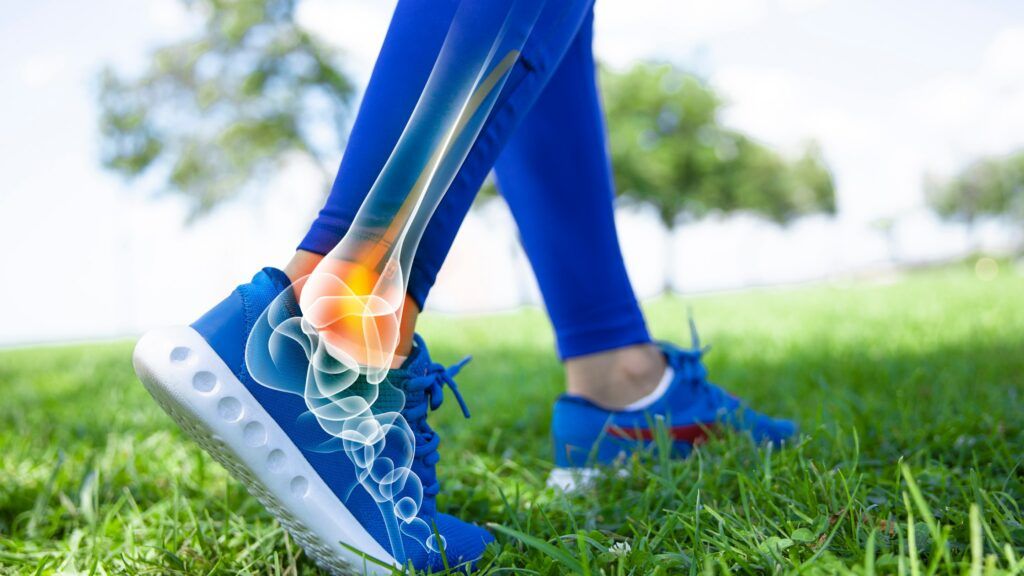Are you seeking improved support, enhanced mobility, and effective pain relief? Look no further than orthotic braces. In this blog, we delve into the world of orthotic braces, unveiling the numerous benefits, types, and conditions they address. Gain valuable insights into managing specific ailments such as plantar fasciitis, scoliosis, and arthritis with the aid of orthotic braces. Discover how these remarkable medical devices can alleviate pain, promote proper posture, prevent injuries, and enhance sports performance.
But that’s not all! We’ll also take you on a journey through proper brace usage, maintenance, and the latest advancements in smart braces. As you delve into this blog, you’ll find yourself equipped with the knowledge to make informed decisions about orthotic braces and unlock their transformative potential in your life.
Understanding Orthotic Braces
These braces offer a range of benefits, from pain relief to improved functionality. They work by aligning and supporting the affected body part, redistributing pressure, and limiting unwanted movements. There are different types of orthotic braces available, each designed for specific conditions and body parts. Back braces help maintain proper spinal alignment, and wrist braces provide stability and alleviate pain in the wrist.
Orthotic braces are recommended in various situations, such as post-surgery recovery, injury rehabilitation, or chronic conditions. These braces are often prescribed by healthcare professionals who assess the patient’s needs and determine the most suitable type of brace. By wearing orthotic braces, individuals can experience improved support, reduced pain, enhanced mobility, and increased confidence in their daily activities. It is important to follow the instructions provided by healthcare professionals regarding the duration and proper usage of the braces to achieve optimal results.
Types of Orthotic Braces
Orthotic braces come in a wide range of types, each specifically designed to address different conditions and body parts. Understanding the various types can help individuals find the most appropriate brace for their needs.
- Ankle braces: Ankle braces are commonly used to provide stability and support for individuals recovering from ankle sprains or suffering from chronic instability. Ankle braces help prevent excessive movements, protect the ankle joint, and promote proper alignment during activities.
- Knee braces: Knee braces offer support and protection for the knee joint. They are available in different designs, such as knee sleeves, wraparound braces, and hinged braces. They help stabilize the knee, reduce pain, and improve overall knee function.
- Back braces: These braces are commonly prescribed for individuals with conditions like herniated discs, spinal stenosis, or muscle strains. Back braces provide external support to the lower back, helping to reduce pressure on the spine and alleviate discomfort.
- Wrist braces: Wrist braces provide stability, restrict movement, and alleviate pain in the wrist. Wrist braces immobilize the wrist joint, allowing it to rest and heal while providing support during daily activities.
- Shoulder braces: These braces work by limiting movement in the shoulder, which helps reduce pain and facilitate the healing process. Their purpose is to provide a secure and comfortable environment for the shoulder, allowing it to recover effectively.
- Elbow braces: These braces are designed to alleviate strain on the tendons and muscles surrounding the elbow, providing much-needed assistance during activities that involve gripping or repetitive arm movements. By wearing an elbow brace, individuals can experience reduced discomfort and enhanced stability, allowing them to engage in their daily tasks or sports activities with greater comfort and confidence.
- Neck braces: Neck braces, also called cervical collars, are utilized to offer support and immobilization for the neck following neck injuries or surgical procedures. By providing stability and reducing strain on the neck, they aid in the recovery process and promote optimal neck health.
It is crucial to consult with a healthcare professional to determine the most suitable type of brace based on the specific condition and individual needs. Proper fitting and usage of the braces are essential for optimal results. With the right brace, individuals can experience improved pain management, enhanced recovery, and increased mobility.
Applications of Orthotic Braces
Managing Plantar Fasciitis Symptoms
Orthotic braces can provide effective relief and assist in managing the symptoms of plantar fasciitis. In combination with other treatments, these braces can significantly reduce pain and promote healing. Orthotic braces are designed specifically for plantar fasciitis and are instrumental in supporting the arch of the foot and relieving stress on the plantar fascia. By providing targeted compression and cushioning, these braces help distribute pressure evenly, alleviate pain, and promote proper alignment. They can be worn inside shoes or as night splints, depending on the individual’s needs and preferences.
It is also essential to modify activities and footwear to avoid exacerbating the condition. Choosing shoes with adequate arch support, cushioning, and a supportive heel counter can alleviate pressure on the plantar fascia. Avoiding prolonged periods of standing or high-impact activities can prevent further irritation and aid in the healing process. With a comprehensive approach that includes orthotic braces and targeted therapies, individuals can effectively manage the symptoms of plantar fasciitis and experience improved comfort and mobility.
Supporting Scoliosis Treatment
Orthotic braces play a crucial role in supporting scoliosis treatment by improving spinal alignment and promoting better posture. Scoliosis, characterized by an abnormal curvature of the spine, requires comprehensive management, and orthotic braces are a key component of this treatment approach. Orthotic braces, also known as scoliosis braces, are custom-made to fit the individual’s unique spinal shape. These braces are typically worn for several hours each day, applying gentle pressure to specific areas of the spine. By doing so, they help guide the growth of the bones and gradually straighten the curvature, aiming to achieve a more aligned spinal position.
Orthotic braces designed for scoliosis treatment are crafted from lightweight and flexible materials to ensure comfort and unrestricted movement. Their discreet design allows individuals to wear them beneath clothing, maintaining a positive body image and boosting self-confidence. Besides supporting the spine, these braces also alleviate muscle strain and fatigue commonly associated with scoliosis. In conjunction with wearing orthotic braces, individuals with scoliosis often undergo physical therapy and perform targeted exercises. These additional therapies help strengthen the muscles supporting the spine and enhance overall flexibility, complementing the benefits of orthotic braces.
Relieve Pain and Enhance Comfort
Orthotic braces are valuable tools for relieving pain and enhancing comfort in various areas of the body. Whether you’re dealing with a specific injury, a chronic condition, or seeking support during physical activities, orthotic braces can provide effective pain relief and improve your overall well-being.
- Supporting Joint Stability: Orthotic braces are designed to support and stabilize joints affected by conditions like arthritis, ligament injuries, or joint instability. For instance, ankle braces can provide stability and restrict excessive movement, reducing the risk of ankle sprains or strains. Similarly, wrist braces help alleviate discomfort associated with conditions like carpal tunnel syndrome and provide support during repetitive motions.
- Alleviating Pressure and Reducing Inflammation: Orthotic braces can alleviate pain by offloading pressure from specific areas of the body. For example, knee braces with unloading features redistribute weight away from the affected compartment, relieving pain caused by conditions such as osteoarthritis. Additionally, braces can provide compression, which helps reduce swelling and inflammation in joints affected by conditions like tendonitis or bursitis.
- Promoting Proper Alignment: Braces such as posture correctors provide gentle support, encouraging proper spinal alignment and reducing strain on the back and neck. By maintaining proper alignment, orthotic braces help alleviate pain associated with poor posture and improve overall comfort, especially for individuals who spend long hours sitting or standing.
- Absorbing Shock and Reducing Impact: Orthotic braces, particularly those designed for sports or high-impact activities, often incorporate shock-absorbing features. These braces help cushion the joints, reduce impact forces, and minimize discomfort during activities such as running or jumping. By absorbing shock and reducing impact, orthotic braces enhance comfort, prevent injuries, and support individuals in maintaining an active lifestyle.
- Customized Support for Specific Conditions: Orthotic braces can be customized to provide targeted support for specific conditions. Individuals with conditions like patellar tendonitis or IT band syndrome can benefit from knee braces designed to alleviate pain in those specific areas. By offering customized support, orthotic braces address the unique needs of individuals with specific conditions, providing effective pain relief and enhanced comfort.
Preventing Injuries with Orthotic Braces
Orthotic braces are essential in the prevention of injuries, particularly for individuals with vulnerable areas or those involved in high-impact activities. These braces serve as a crucial support system, offering stability and protection to susceptible joints and muscles.
- Supporting Weak Areas: Individuals with weak musculoskeletal structures greatly benefit from orthotic braces. For example, ankle braces are commonly used to support weak or unstable ankles. By stabilizing the joint and limiting excessive movement, they effectively reduce the risk of ankle sprains during activities like running, jumping, or pivoting. Similarly, knee braces can offer support to weak or injured knees, providing stability and preventing sudden movements that may lead to further harm.
- Reducing the Risk of Further Damage: Orthotic braces play a vital role in minimizing the risk of aggravating existing injuries. By acting as a protective barrier, they alleviate stress in vulnerable areas, allowing them to heal properly. With their support and motion-limiting features, these braces prevent further strain or trauma to injured muscles, tendons, ligaments, or joints. For instance, individuals with wrist injuries can find relief through wrist braces, which immobilize the wrist and prevent unnecessary movements that could worsen the injury.
- Enhancing Performance and Stability: Orthotic braces not only prevent injuries but also enhance performance and stability during physical activities. Athletes, in particular, can reap the benefits of braces specifically designed for their sport or activity. These braces are crafted to provide targeted support, reduce joint fatigue, and improve overall performance. For instance, knee braces are frequently worn by athletes engaged in contact sports to shield their knees from impact and twisting forces.
It is crucial to note that while orthotic braces are highly effective in injury prevention, they should be complemented with a comprehensive approach including appropriate warm-up exercises, conditioning programs, and technique training. Consulting with a healthcare professional or sports medicine specialist is advisable to determine the most suitable type of brace and develop an individualized injury prevention plan.
Properly Wearing Orthotic Braces
To maximize the benefits and ensure optimal support and functionality of orthotic braces, it is important to follow the correct techniques for wearing them.
- Choose the Right Size and Fit: Selecting the appropriate size and fit is crucial for the effectiveness of orthotic braces. Get instructions from a professional to determine the right size for your needs. Ill-fitting braces may not provide adequate support and can lead to discomfort or ineffective treatment.
- Read and Follow Instructions: Thoroughly read and understand the instructions that come with your orthotic braces. Pay attention to any specific guidelines for wearing the braces during different activities or at specific times of the day.
- Wear Braces Consistently: Consistency is key when it comes to deriving maximum benefits from orthotic braces. Wear them as recommended, following the prescribed wearing schedule, whether it is for a certain number of hours per day or during specific activities. Consistent use allows your body to adapt to the brace and experience the intended effects.
- Position Braces Correctly: Ensure that you position the braces correctly on your body. Follow any marked indicators or align the brace according to anatomical references. Proper positioning is essential to maintain the support and functionality of the brace.
- Adjust Braces Properly: Many orthotic braces offer adjustability to provide a customized fit. Take the time to adjust the braces properly to ensure optimal support and comfort. These instructions are for tightening or loosening straps, buckles, or closures to achieve the desired level of compression or stability.
- Wear Appropriate Footwear: Orthotic braces often need to be worn with specific types of footwear for proper function. Follow the recommendations provided with the braces and choose shoes that accommodate the brace without compromising its fit or effectiveness.
- Maintain Proper Hygiene: Regularly clean and maintain your orthotic braces to ensure hygiene and extend their lifespan. Follow the manufacturer’s instructions for cleaning and storage. Keeping the braces clean and dry will prevent the buildup of bacteria, odor, and potential skin irritations.
Smart Braces
Smart braces have revolutionized the field of orthotic care by incorporating advanced technology to enhance monitoring, provide personalized support, and improve treatment outcomes. Equipped with sensors and connectivity features, smart braces enable real-time monitoring of joint movement, muscle activity, and range of motion. This data offers valuable insights for patients and healthcare professionals, allowing for a comprehensive understanding of treatment effectiveness, progress, and areas for improvement. With continuous monitoring, wearers can actively participate in their recovery and make informed decisions about their orthotic care.
With ongoing advancements in smart technology, the potential for smart braces continues to expand. Future developments may include artificial intelligence algorithms that can analyze real-time data, provide personalized feedback, and even predict issues or suggest preventative measures. By staying informed about the latest advancements in smart braces, individuals can make informed decisions about their orthotic needs and embrace the benefits of this exciting field, ultimately experiencing enhanced comfort, control, and treatment outcomes.
Orthotic Braces from Leading Indian Manufacturers
VIZBL Post-Op Knee Brace
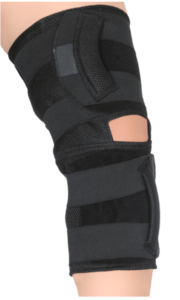 The VIZBL Post-Op Knee Brace, manufactured by Prodancy Pvt. Ltd., is a highly advanced orthotic device designed to promote accelerated recovery and better pain management. This knee brace utilizes the renowned R.I.C.E. (Rest, Ice, Compression, Elevation) approach to provide comprehensive support and aid in the healing process. With its unique gel-based cold compression pad, it offers 360-degree uniform cold compression, covering 15 inches of the thigh and calf muscles. This ensures patient comfort and facilitates speedy healing. The VIZBL Post-Op Knee Brace delivers 360 degrees of uniform compression across the knee, thigh, and calf muscles, resulting in less discomfort and faster recovery.
The VIZBL Post-Op Knee Brace, manufactured by Prodancy Pvt. Ltd., is a highly advanced orthotic device designed to promote accelerated recovery and better pain management. This knee brace utilizes the renowned R.I.C.E. (Rest, Ice, Compression, Elevation) approach to provide comprehensive support and aid in the healing process. With its unique gel-based cold compression pad, it offers 360-degree uniform cold compression, covering 15 inches of the thigh and calf muscles. This ensures patient comfort and facilitates speedy healing. The VIZBL Post-Op Knee Brace delivers 360 degrees of uniform compression across the knee, thigh, and calf muscles, resulting in less discomfort and faster recovery.
Medemove Cast Shoe
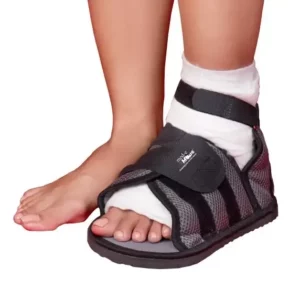 The Medemove Cast Shoe, manufactured by Medequip Healthcare Solutions LLP, is a high-quality orthotic brace specifically designed to provide stability and protection to the foot while walking. This cast shoe is an excellent choice for individuals with orthopedic casts, as it helps protect the plaster from dirt, damage, and cuts. It is adjustable and offers excellent fitting, ensuring optimal comfort and support. Constructed with premium foam and cast-friendly materials, the Medemove Cast Shoe combines durability with comfort, facilitating a smooth and secure walking experience for individuals with casts.
The Medemove Cast Shoe, manufactured by Medequip Healthcare Solutions LLP, is a high-quality orthotic brace specifically designed to provide stability and protection to the foot while walking. This cast shoe is an excellent choice for individuals with orthopedic casts, as it helps protect the plaster from dirt, damage, and cuts. It is adjustable and offers excellent fitting, ensuring optimal comfort and support. Constructed with premium foam and cast-friendly materials, the Medemove Cast Shoe combines durability with comfort, facilitating a smooth and secure walking experience for individuals with casts.
Aramban’s Clavicle Support
Aramban’s Clavicle Support, manufactured by Arambans Exporters (Pvt) Ltd., is a top-notch orthotic brace designed to limit shoulder movement and stabilize the clavicle. This support brace features a shoulder foam pad that provides optimal comfort during use. Its Velcro design allows for easy application and removal, ensuring convenience for the wearer. Aramban’s Clavicle Support is available in various sizes (S, M, L, XL), catering to a wide range of body types and providing a customized fit for effective support and stabilization of the clavicle.
ROM Knee Brace
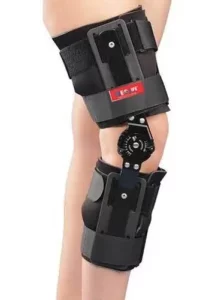 The ROM Knee Brace, manufactured by Aadhar Medicare Private Limited, is a highly effective orthopedic device designed to aid in post-surgery recovery, ligament tear rehabilitation, and joint stabilization. The ROM Knee Brace, skillfully applied by Orthotists, effectively limits particular ranges of motion at the knee, delivering accurate safeguarding and assistance to patients during the post-operative phase after knee procedures. The ROM Knee Brace allows a gradual range of motion rehabilitation with adjustable flexion and extension settings, enabling optimal recovery and rehabilitation progress. Additionally, pediatric sizes are available for children with knee injuries, ensuring comprehensive care and support.
The ROM Knee Brace, manufactured by Aadhar Medicare Private Limited, is a highly effective orthopedic device designed to aid in post-surgery recovery, ligament tear rehabilitation, and joint stabilization. The ROM Knee Brace, skillfully applied by Orthotists, effectively limits particular ranges of motion at the knee, delivering accurate safeguarding and assistance to patients during the post-operative phase after knee procedures. The ROM Knee Brace allows a gradual range of motion rehabilitation with adjustable flexion and extension settings, enabling optimal recovery and rehabilitation progress. Additionally, pediatric sizes are available for children with knee injuries, ensuring comprehensive care and support.
AR-4060 Cast Shoe
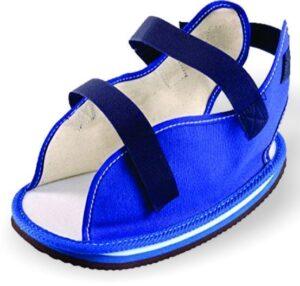 ASKP SOLUTIONS brings you the AR-4060 Cast Shoe, an orthotic brace designed to enhance stability while walking for individuals with casts. Available in small, medium, large, and extra-large sizes, this shoe-shaped cast shoe is constructed with a sturdy coated cloth material, ensuring durability and longevity. It features a rubber sole with foam padding for added comfort and protection. The AR-4060 Cast Shoe is equipped with velcro straps that ensure a secure and customized fit, preventing the chipping, cracking, and soiling of the plaster. With its design focused on stability and support, this cast shoe facilitates confident and secure movement during the recovery process.
ASKP SOLUTIONS brings you the AR-4060 Cast Shoe, an orthotic brace designed to enhance stability while walking for individuals with casts. Available in small, medium, large, and extra-large sizes, this shoe-shaped cast shoe is constructed with a sturdy coated cloth material, ensuring durability and longevity. It features a rubber sole with foam padding for added comfort and protection. The AR-4060 Cast Shoe is equipped with velcro straps that ensure a secure and customized fit, preventing the chipping, cracking, and soiling of the plaster. With its design focused on stability and support, this cast shoe facilitates confident and secure movement during the recovery process.
Conclusion
Orthotic braces have revolutionized the field of healthcare, providing invaluable support, enhanced mobility, and much-needed pain relief. By understanding the diverse types of orthotic braces available and their specific applications, individuals can make informed choices to improve their overall quality of life. Whether managing conditions like plantar fasciitis, scoliosis, or arthritis, or aiming to boost athletic performance, orthotic braces offer targeted solutions tailored to individual needs. These braces alleviate discomfort, promote proper alignment and aid in injury prevention. Furthermore, the integration of technology in smart braces has opened up new possibilities, enabling personalized support and improved treatment outcomes.
By following proper usage guidelines and maintaining orthotic braces, individuals can ensure long-lasting effectiveness and functionality. Staying updated on the latest advancements in orthotic braces empowers individuals to embrace the transformative potential of these devices, fostering better posture, enhanced well-being, and an active lifestyle. With Medzell‘s orthotic braces, individuals can regain control over their health, overcome physical challenges, and enjoy a life filled with support, mobility, and relief.
